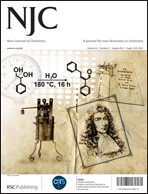A series of six new n-type conjugated 1,8-naphthyridine oligomers were examined in organic light emitting diodes (OLEDs). The compounds show a high fluorescence in both solution (10−8 M) and the solid state. The naphthyridines have high glass-transition (Tg = 65–105 °C) and decomposition (Td = 380–400 °C) temperatures, reversible electrochemical reduction, and high electron affinities (2.79–3.00 eV). Systematic variation of the spacer linkage can modulate and fine-tune their properties. They emit high blue, green and yellow photoluminescence with 0.70–1.0 quantum yields. Good-performance, single-layer emitter OLEDs with yellow to white-pink emission have also been demonstrated using these materials. White-pink emitter give a performance with a high brightness (400 cd m−2 at 4 V), and 0.6 cd A−1. Yellow emitters give the best performance with maximum brightness of 250 cd m−2 with a maximum current efficiency of 1.2 cd A−1. These results demonstrate the potential of this new class of n-type conjugated oligomers as emitters and electron-transport materials for developing high-performance yellow to white-pink OLEDs.

You have access to this article
 Please wait while we load your content...
Something went wrong. Try again?
Please wait while we load your content...
Something went wrong. Try again?


 Please wait while we load your content...
Please wait while we load your content...